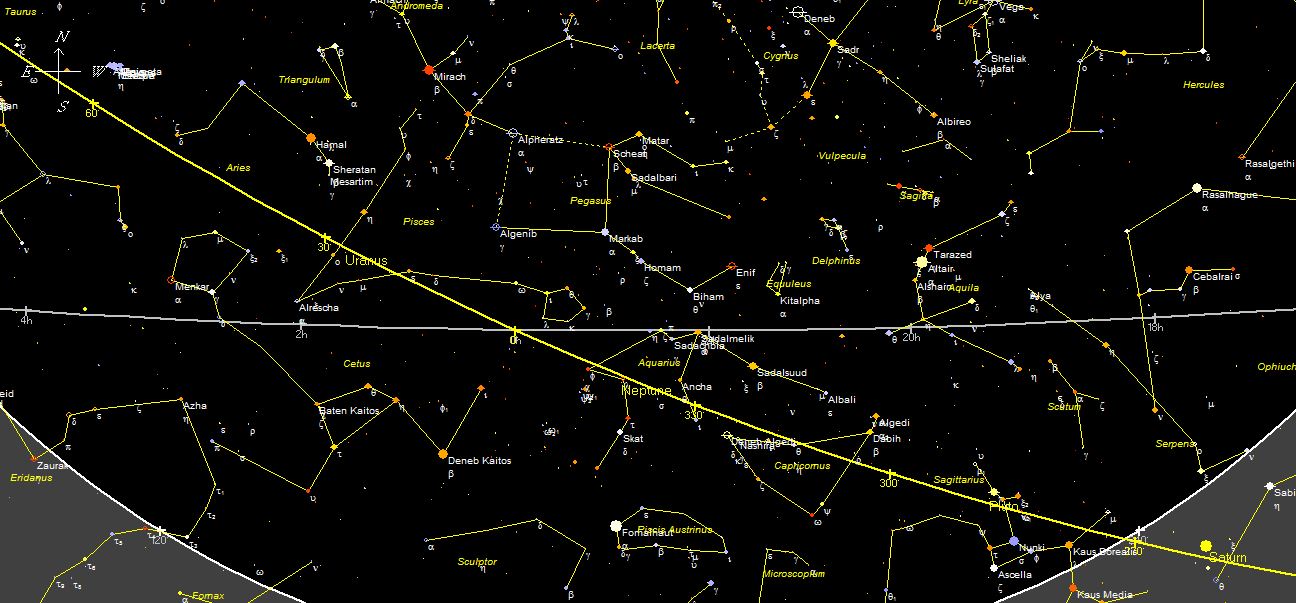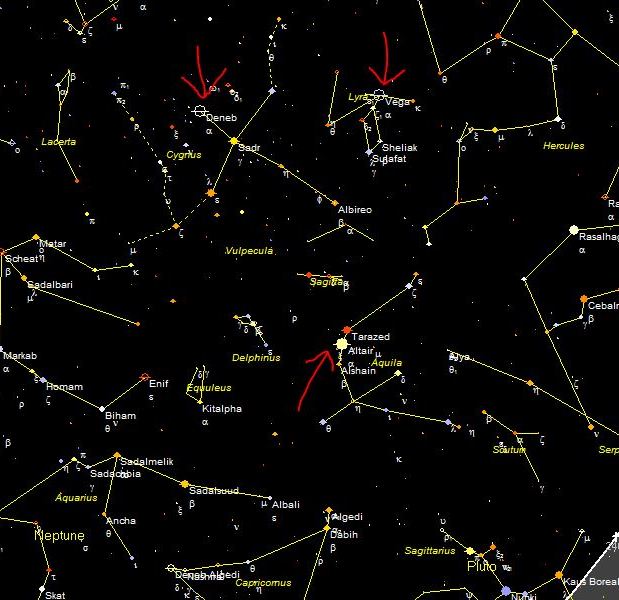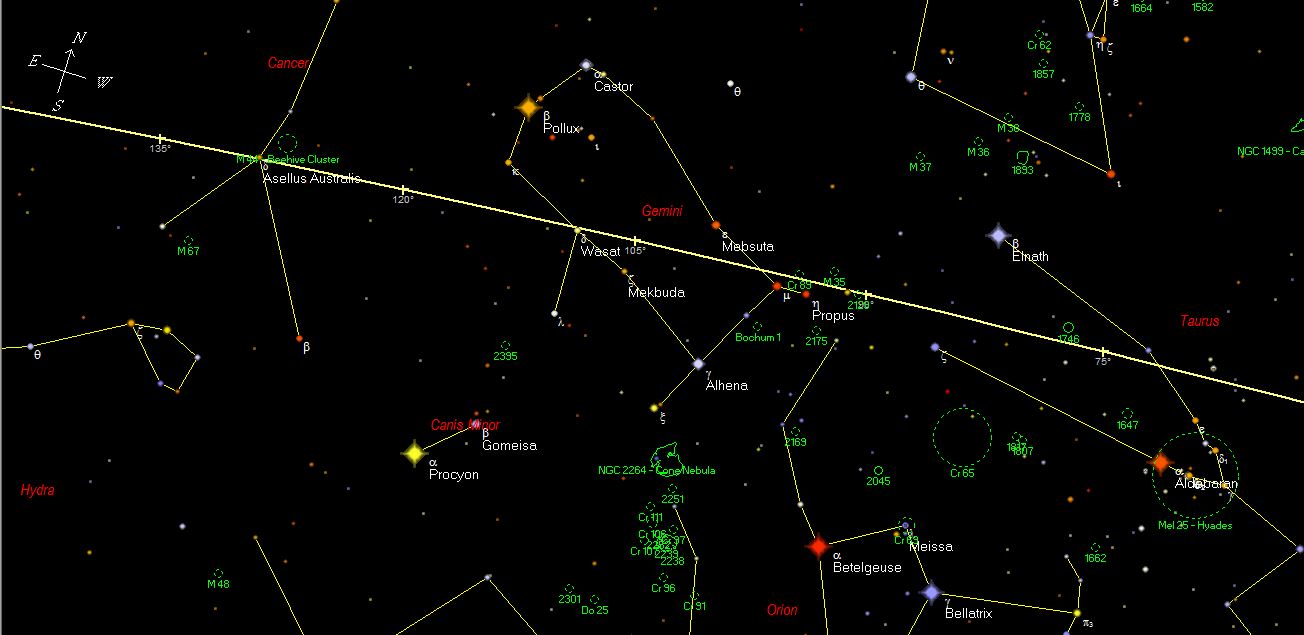
The summer triangle still in the autumn sky
The Sun is in Virgo since September 16th and remains there for the whole month to spend October 31st in Libra, with all due respect for the astrologers who remained at the positions of the Sun of 2000 years ago, a century plus a century less.
Capricorn, Aquarius, Pisces and Aries are the constellations of the evening from west to east, made up of not very bright stars; we will have to wait until late at night to enjoy the Bull and Orion.
Looking up from the South-West towards the Zenith there is a triangle of stars, the Summer Triangle, observable throughout the summer and beyond. It is made up of 3 stars from 3 different constellations: the brightest Vega della Lira, Deneb del Cigno and Altair dell’Aquila.

The Lira is a small quadrilateral of stars that represents the harp of Orpheus. Vega, in Lirae [1], is a white-blue star, fifth in brightness in the sky, which is 27 light years away from us (so we see it as it was 27 years ago). It shines like 60 suns but for its distance it has an apparent magnitude equal to 0 [2].
Sheliak, b Lirae, is a double star with a companion that rotates around it in 13 days so its brightness is variable. and Lirae is the most famous quadruple star in the sky, known as the Double Double, two white double mag stars. 5. Between b and g Lirae there is the famous Annular Nebula, M57, a planetary nebula, disc of gas and dust with a central white dwarf, formed by the explosion of a star.
The Swan is represented by a cross of stars, immersed in a dense zone of stars and interesting objects of the Milky Way, on the opposite side of the Galactic Center; contains an area without dark dust, called the Sack of coal, which does not allow you to see the stars in the background.
Deneb, in Cygni, in Arabic for the tail, is a supergiant white-blue star of 1.3 mag, which shines like 60,000 suns and is 1,600 light years away. Albireo, b Cygni, is one of the most beautiful doubles in the sky, a yellow giant of mg.3 accompanied by a blue one of magnitude 5, visible with good binoculars. In this constellation, near the star h Cygni, the first Black Hole, Cygnus X-1, has been identified, recognized as a source of X rays.
According to Greek mythology, the constellation represents the Swan under whose likeness Zeus seduced Leda, wife of King Tindaro with whom the woman then lay the same night; for which he conceived two twins, Castor and Pollux, the first mortal and the other immortal because he was the son of Zeus.
The Eagle is a constellation in which its brightest star, Altair in Arabic precisely means flying eagle; the white star has 0.8 mag, shines like 10 suns and is 16 light years away.
In mythology the Eagle was the bird of Zeus who carried the god’s lightning back and forth hurled against his enemies; she was also placed to guard the Arrow (nearby constellation) of Eros that had hit Zeus and made him fall in love with the young Ganymede.
[1] The stars are indicatednot only with names deriving from the Arabicor Latin or Greek tradition, but also with the Greek letters and the Latin genitive of the constellation they belong to. It usually startswith the brightest, alpha, then beta, and so on.
[2] The apparent magnitude of a star is an inverse scale ranging from 1 to 6, invented by Hipparchus (190-127 BC). For each degree of the scale, the brightness decreases by 2.5 times. The brightest have mag values. lower. Lower and negative values are also used today.
______________________________________________
The sky maps are taken from Skymap, a software downloadable in demo version from the website http://www.skymap.com
Credits
Author: Lucia Corbo. As a Natural Sciences teacher and expert in didactics of Astronomy, she has collaborated with various magazines curating articles, columns, and multimedia materials. For the Italian Ministry of Education, she edited the cd “Students show the stars” and with N. Scarpel the book “Astronomy on the net”; she promoted and coordinated the first editions of Astronomy Weeks for schools. She has held multiple refresher courses on the didactics of Science and Astronomy and Astronomy courses for students and adults, both in presence and online.
Translation by Maria Antonietta Sessa




